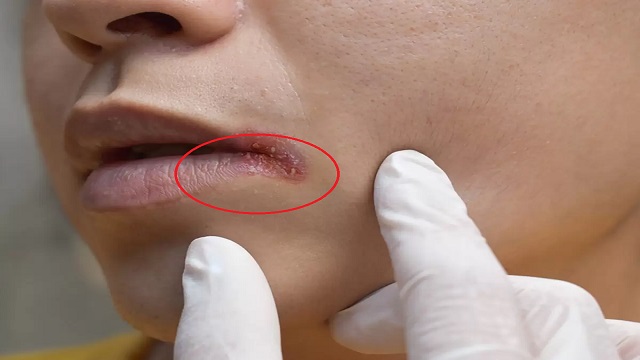What is Angular Cheilitis?
Angular cheilitis is an inflammatory skin condition that affects one or both corners of the mouth. This skin condition causes sores and cracks in the corners of the mouth.
Although painful, angular cheilitis is usually mild and not contagious. It can last for a few days or persist indefinitely.
Symptoms of Angular Cheilitis
Angular cheilitis symptoms only appear at the corners of the mouth. The condition can be painful and vary in shape and color. It usually ranges from mild redness to open, bleeding blisters.
If you experience this disorder, the corners of your mouth will appear:
- Itchy rash.
- It hurts.
Other symptoms of angular cheilitis may include:
- Oral fungal infection (thrush). Get to know the triggers in this article: “ These are 5 Causes of Thrush and How to Treat It ”.
- Eczema-type rash on the lower face.
- Redness of the roof of the mouth in denture wearers.
- There is saliva in the corners of the mouth.
- Deep cracks at the corners of the lips.
Causes of Angular Cheilitis
Angular cheilitis occurs due to the accumulation of saliva and the type of skin on the lips that tends to be dry. Over time, dry skin can become cracked, increasing the risk of bacteria or fungi entering.
There are also several diseases that can cause angular cheilitis, such as:
- Atopic dermatitis or eczema.
- The habit of drooling while sleeping.
- Fungal or yeast infections in the mouth, such as thrush.
- Misaligned teeth position.
- Suffering from skin allergies.
- Wearing a face mask.
Risk Factors for Angular Cheilitis
Angular cheilitis is more likely to occur in people who have moist corners of the mouth. This can happen for a variety of reasons, such as:
- Using braces.
- Wearing ill-fitting dentures.
- The habit of licking your lips frequently.
- Have a lot of saliva.
- Having crooked teeth.
- Loose skin around the mouth due to weight loss or age.
- Having a habit of sucking a thumb or pacifier.
- Active smoker. Find out here, “ 9 Effective Tips to Quit Smoking ”.
- Not getting enough nutrients, such as B vitamins or iron.
There are certain medical conditions that can increase the risk of developing angular cheilitis, such as:
- Blood cancer.
- Down syndrome.
- Immune disorders, such as having human immunodeficiency virus(HIV).
- Kidney, liver, lung, or pancreatic cancer.
Diagnosis of Angular Cheilitis
Some procedures that can help the medical team in diagnosing disorders include:
- Medical interview
Medical interview to collect relevant medical information about the patient’s medical history. Including current complaints, medical history, and previous treatment procedures.
- Physical examination
Next, the doctor will examine your mouth to check for cracks, redness, swelling, or abrasions. They will also ask about habits that may be contributing to your lip problems.
- Supporting examinations
The doctor will swab the corners of the mouth and nose to collect saliva. The doctor will then send it to a lab to see what type of bacteria or fungus is causing angular cheilitis.
Angular Cheilitis Treatment
The treatment plan will depend on the cause. Some treatment procedures include:
- Antibiotics
The use of this antibiotic drug consists of two ways, namely oral and topical. Whatever the type of drug, the use of antibiotics aims to help treat bacterial infections.
- Dental care
Make sure you wear dentures or braces in the correct position. Because misaligned teeth when biting can cause or even worsen existing symptoms.
- Changes in eating patterns
Consume foods rich in protein, iron, and vitamin B. This is done to help overcome problems that occur due to poor diet or nutritional deficiencies.
- Ointment or cream
Topical antifungal or steroid creams can help relieve swelling and pain from cracks in the corners of your mouth. You can also use lip balm or petroleum jelly to keep your mouth moist.
Complications of Angular Cheilitis
Complications of the disease can occur if the cause is a bacterial or fungal infection. If you experience this, the infection can spread to the surrounding skin and cause canker sores.
Other complications include:
- Difficulty speaking.
- Difficulty eating and drinking.
- Swelling and inflammation.
- Infection that doesn’t get better.
- Decreased self-confidence due to wounds that interfere with appearance.
How to Prevent Angular Cheilitis
Some steps you can take to prevent angular cheilitis include:
- Keeps lips dry.
- Don’t lick your lips.
- Treat the underlying condition.
- Use lip balmor petroleum jelly.
- Practice good oral hygiene.
- Do not smoke or use tobacco products.
- Do not use expired cosmetics.
- Rinse mouth after using inhalation.
When to See a Doctor?
Discuss with a dermatologist if you experience:
- Wounds that last more than 2 weeks.
- Experiencing severe symptoms.
- There is a wound near the eye.
- Pain that spreads to other areas of the body.

